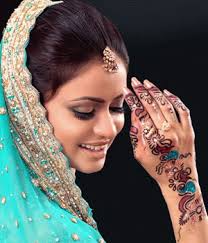Beautiful Models With Mehandi Design Biography
Mehndi or Henna is a paste that is bought in a cone shaped tube and is made into designs for men and women. It is also derived from the Sanskrit word mendhikā.[1] The use of mehndi and turmeric is described in the earliest Hindu Vedic ritual books. It was originally used for only women's palms and never for men, but as time progressed, it is more natural for men to wear it. Haldi (staining oneself with turmeric paste) as well as mehndi are Vedic customs, intended to be a symbolic representation of the outer and the inner sun. Vedic customs are centered around the idea of "awakening the inner light". Traditional Indian designs are of representations of the sun on the palm, which, in this context, is intended to represent the hands and feet.For over five thousand years henna has been a symbol of good luck, health and sensuality in the Arab world. The plant has been associated with positive vibes and provides a link to an ancient age full of good and bad spirits, Baraka and Jnoun. Generations of women have used a paste made primarily of dried ground henna leaves to cover their hands and feet with designs ranging from simple blobs to intricate geometric patterns designed to ward off evil, promote fertility and attract good energy.
While there is some controversy over the origins of the use of henna as a dying agent, the earliest clear evidence of henna application on the body appears in Egyptian mummies whose hair and nails were stained with the reddish brown tones of henna. Botanists believe the henna plant, Lawsonia inermis, originated in Egypt and was carried regularly to India where it was used since at least 700 AD for decorating hands and feet. Historically henna has also been used for medicinal purposes, to dye cloth and leather as well as hair, to color the manes of horses and other fur of other animals.
Practiced mainly in India and the Arab world, mehndi or henna is the application of as a temporary form of skin decoration, popularized in the West by Indian cinema and entertainment industry, the people in Nepal, Pakistan, Bangladesh and the Maldives also use mehndi. Mehndi decorations became fashionable in the West in the late 1990s, where they are called henna tattoos.
Mehndi in Indian tradition is typically applied during special Hindu weddings and Hindu festivals like Karva Chauth, Vat Purnima, Diwali, Bhai Dooj and Teej. In Hindu festivals, many women have Henna applied to their hands and feet and sometimes on the back of their shoulders too, as men have it applied on their arms, legs, back, and chest. For women, it is usually drawn on the palm, back of the hand and on feet, where the design will be clearest due to contrast with the lighter skin on these surfaces, which naturally contain less of the pigment melanin. Henna was originally used as a form of decoration mainly for Hindu brides. Muslims of Indian subcontinent also apply Mendi during their festivals like Eid-ul-Fitr and Eid-ul-Adha.
Beautiful Models With Mehandi Design

Beautiful Models With Mehandi Design
Beautiful Models With Mehandi Design

Beautiful Models With Mehandi Design
Beautiful Models With Mehandi Design

Beautiful Models With Mehandi Design
 Beautiful Models With Mehandi Design
Beautiful Models With Mehandi Design

Beautiful Models With Mehandi Design

Beautiful Models With Mehandi Design
Beautiful Models With Mehandi Design
No comments:
Post a Comment